The Northern Pygmy-Owl (Glaucidium gnoma)
The cutest Murderer in North America
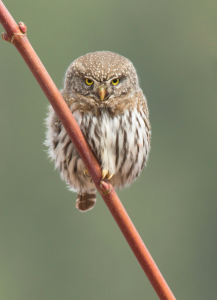
NPOW perching. Picture taken by Damon West
The Northern Pygmy-Owl (Glaucidium gnoma or NPOW) is an elusive beast, not because of its size (as you might gather from its name it is a rather small creature) but rather due to its aggressive hunting style (Darling, 2003; Sibley, 2016).
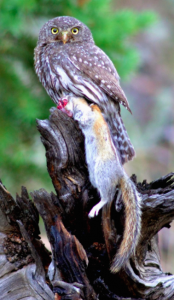
NPOW consuming chipmunk. Picture by Scott Rashid
“Elusive” is also an apt term to describe the Northern Pygmy-Owl, as they are a rather secluded and secretive species that typically live deep in old growth forests (Darling, 2003). They are a difficult species to study because they are asocial creatures and their are not many to begin with (Darling 2003). Also as they are a resident species we cannot take advantage of bottleneck areas during migration as is done with the Northern Saw-whet Owl (Darling, 2003, BirdLife International, 2014).
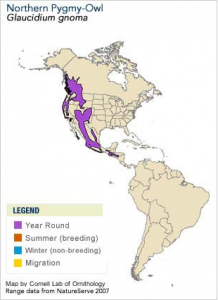
NPOW distribution, Taken from Cornel Lab of Ornithology
As it stands, there have yet to be estimates made of how many Northern Pygmy-owls exist (Darling, 2003). It is suspected that their populations may be decreasing; however, it is still considered to be a species of least concern in terms of conservation efforts (Darling, 2003; BirdLife International, 2014). Interestingly enough we do know that this species ranges from northern Canada to Nicaragua (Birds of North America; Sibley, 2016).
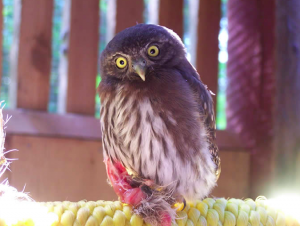
NPOW subspecies swarthi taken by Unknown
As to how the Northern Pygmy-owl fits onto the evolutionary tree, there is some confusion –to put it mildly. If you want to develop a headache try comparing old scientific papers on the Norther Pygmy-Owl to modern ones, but I digress. In short, most agree that its species name is gnoma (though Wikipedia doesn’t agree), and because life is cruel, this species is further broken down into subspecies (Birds of North America; Darling, 2003; Sybley, 2016). However, to quote Darling “Taxonomy of the subspecies is complex and requires further clarification” (Darling, 2003). But, good news! We can agree that the species local to Vancouver island and its associated islands belong the swarthi subspecies (Darling, 2003).
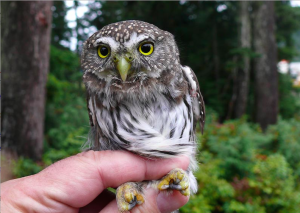
Young NPOW in photographers grip. Taken by Unknown
How big is this creature? Take a moment to picture a tall Starbucks latte, drink the coffee (yes, it’s coffee), congratulations! You now hold a device large enough to entrap a Northern Pygmy owl* or, if you want to be ‘sciency’ about it, the owl is approximately 6.5” tall (from bill tip to tail tip) with a wingspan of 12″, and a surprisingly long tail of about 2″ (Sibley, 2016).
*I do not endorse the trapping of small owls in coffee cups.
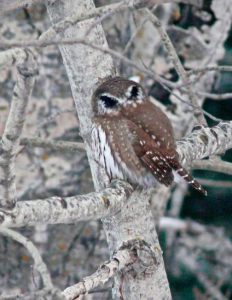
Perching NPOW, eyespots visible, Photo taken by Anna Elliot
Its feathers range from a vibrant reddish brown to a calming grey brown, depending on subspecies and region, which only makes its very yellow eyes and feet all the more terrifying (Darling, 2003; Sibley, 2016). They also have a white underbelly with brown stripes and menacing white eyebrows i.e. supercilium (Sibley, 2016). Another striking feature shared by all pygmy owls is black spots with a white ring on the back of their heads, which mimic their eyes, these are rather uncreatively referred to as eyespots (Deppe et al, 2003; Sibley, 2016).
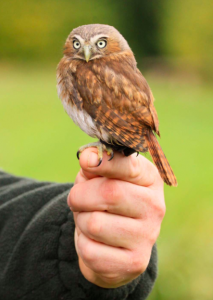
FPOW Taken by Trevor Hill
In north america the Northern Pygmy-Owl is pretty distinct from other owls of similar size. However, in the United States and in central america positive identification becomes more difficult thanks to the Ferruginous Pygmy-Owl (Glaucidium brasilianum) which differ only in being a slightly more red reddish brown then its northern counter parts (Sibley, 2016).
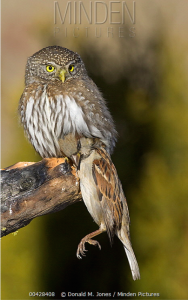
Just in case you forgot they were little murderers. NPOW with song bird. Photo taken by Donald Jones
When it comes to habitat the Northern Pygmy-owl isn’t too picky, they are largely generalist but have a slight proclivity for old growth forests, where they can murder in peace (Darling, 2003; Sibley, 2016). This makes logging the main area of concern in terms of future conservation efforts, especially on Vancouver Island where old growth forests are becoming rarer (Darling, 2003; BirdLife International, 2014).
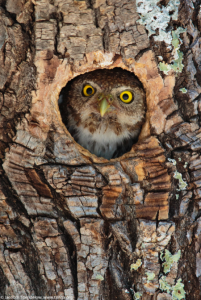
NPOW in nest. Photo Taken by Jacob Spendelow
The northern pygmy owl is a diurnal solitary creature, it mostly eats song birds and small mammals but won’t pass up a good insect (Darling, 2003; Deshler & Murphy 2012; Frye & Jageman, 2012; Sibley, 2016). These agile fliers can actually chase down their prey and don’t rely solely upon being cowards and surprising them (Darling, 2003; Deshler & Murphy 2012). Due to its unsavoury habit of eating song birds, song birds will often gather to mob Northern Pygmy-owl’s (Deppe et al, 2003).
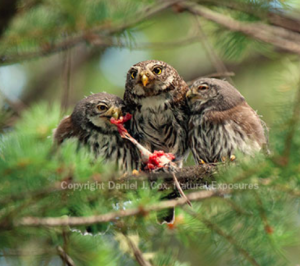
NPOW mother & chicks consuming some prey, taken by Daniel Cox
The Northern Pygmy-Owls are monogamous species, but only for a single mating season (Darling, 2003; Birds of North America). Both parents will care for the offspring; the mother will brood the chicks, the male will feed her until they hatch at which point they both go hunting to provide for their little carnivores (Deshler & Murphy 2012; Frye & Jageman, 2012). They nest in holes in trees, these can be naturally occurring or by squatting in a woodpeckers hard earned crevice they pecked themselves (Darling, 2003; Frye & Jageman, 2012).
Also if you ever wanted to hear the fearsome roar of the Northern Pygmy-owl Steve Large has got you covered.
In summary, the Northern Pygmy-Owl is a fascinating poorly studied little monster, I hope you found this angry fluff ball to be as amusing as I did!
P.S. Fun fact! Fledgling Norther Pygmy-owls when first learning to fly often fail and will instead end up hanging upside down… this is the results.
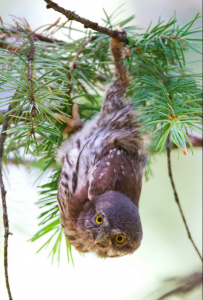
Fledgling NPOW hanging. Taken by Paul Bannick
SOURCES
BirdLife International. 2014. Glaucidium gnoma. The IUCN Red List of Threatened Species 2014
Darling, L. M. B.C Ministry of Water, Land and Air Protection Biodiversity Branch (2003) Status of the Vancouver Island Northern Pygmy-Owl (Glaucidium gnoma swarthi) in British Columbia. Wildlife Bulletin.
Deppe, C., Holt, D., Tewksbury, J., Broberg, L., Petersen, J., & Woo, K. (2003). Effect of the Northern Pygmy-Owl (Glaucidium gnoma) eyespots on avain mobbing. The American Ornithology Society. 120(3), 765-771.
Deshler, J. F. & Murphy, M. T. (2012) The Breeding Biology of the Northern Pygmy-Owl: Do the smallest of the small have an advantage? The Condor. 114 (2), 314-322.
Frye, G. G. & Jageman, H. R. (2012). Post-Fledging Ecology of Northern Pygmy-owls in the rocky mountains. The Wilson Journal of Ornithology 124(2): 199-207.
Sibley, D. A. (2016) The Sibley Field Guide to Birds of Western North America: Second Edition. Knopf Doubleday Publishing.
Loved the post, and I am 100% behind the “no trapping owls in Starbucks cups” thing! One question: because of their small size, are they often subject to predation by other birds, etc? Or does their agility and size help them to better avoid and hide from predators, making them a less common prey item?
Thanks and great question! While their agility does help, they are definitely subject to predation, mostly from larger avian predators. The NPOW are less common as a prey species in terms of the predators perspective, but I believe this has more to do with how uncommon NPOWs are as a species as opposed to their agility.
Awesome post! The photographs really matches what you were talking about ! (also I think there is a typo in the paragraph next to the chipmunk photo, it says owl growth forests, i think you mean old growth forests. But fantastic work : )
Although, if you actually mean owl growth forests…I really need to find on of these ; )
Hahah I wish there was! I did indeed mean old growth forest. Thanks 🙂
Such a cool species! Any tips on seeing one?
The best tips I’ve heard for seeing them is keeping track of sightings on places like eBird, or checking locations where they have been previously spotted as they are fairly territorial so they are likely to be found in the same location. Sorry I couldn’t be of more help! Good luck!
Interesting post! Seeing your first one is definitely a highlight. Took me a long time, but a great memory. Best if it’s one that you find yourself, but Having an idea where to look really helps. Need a special NPOW field trip.